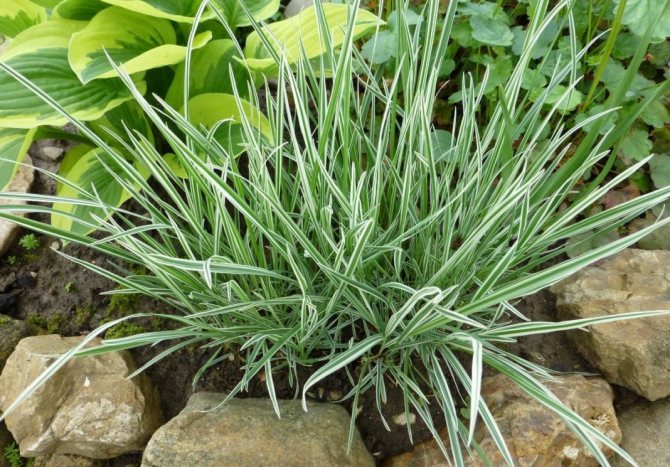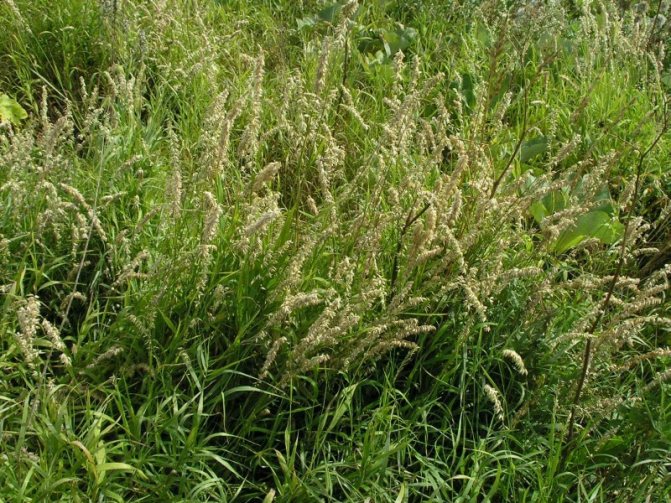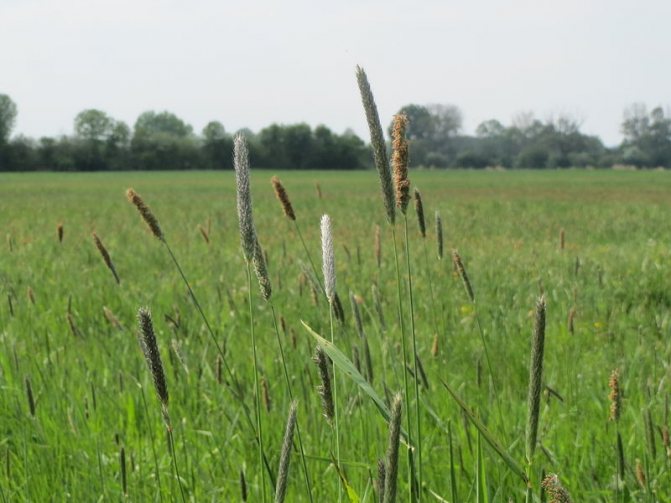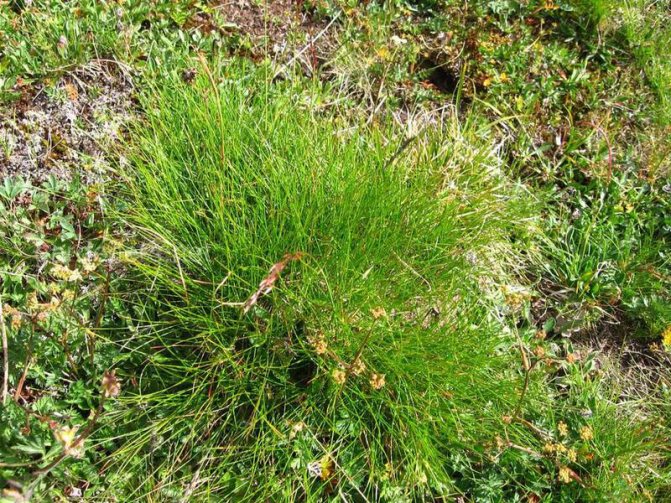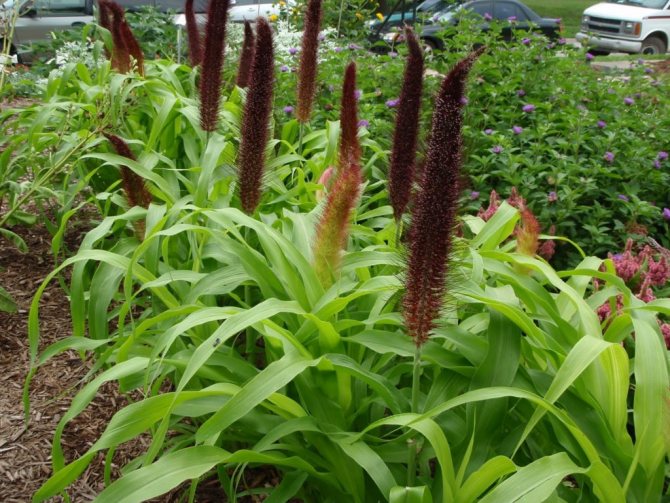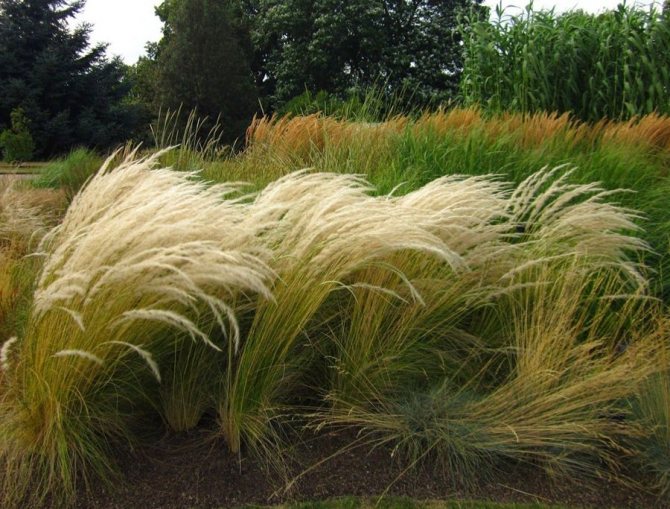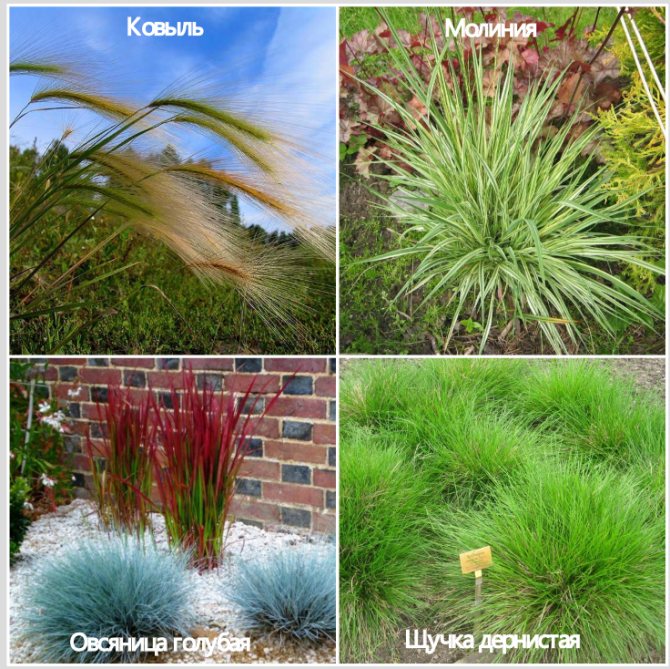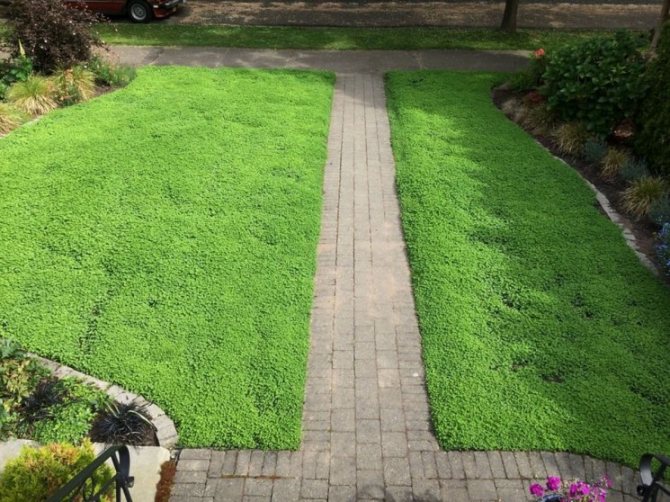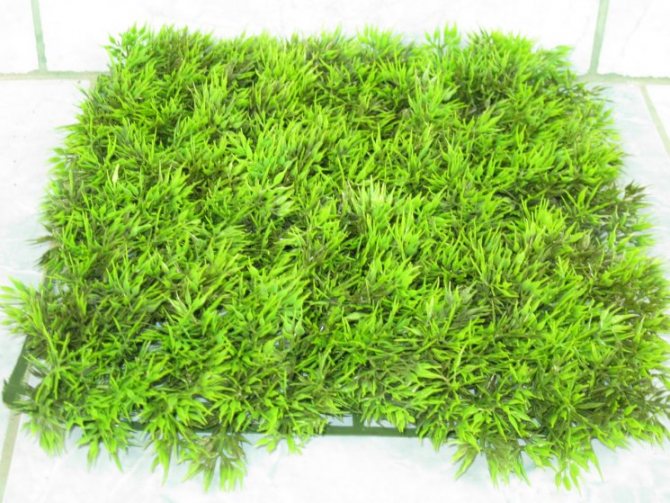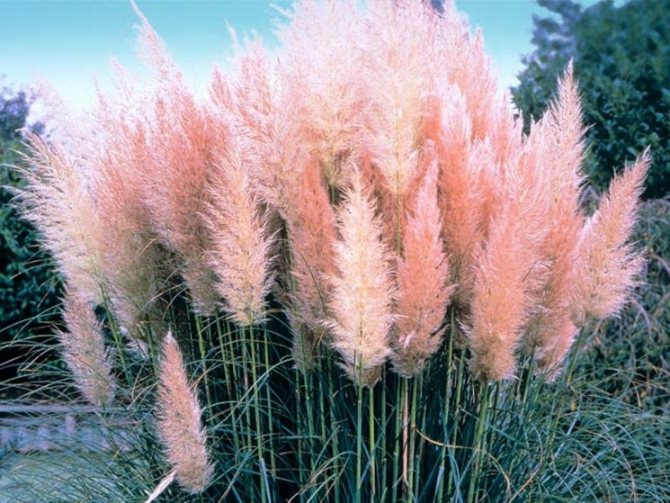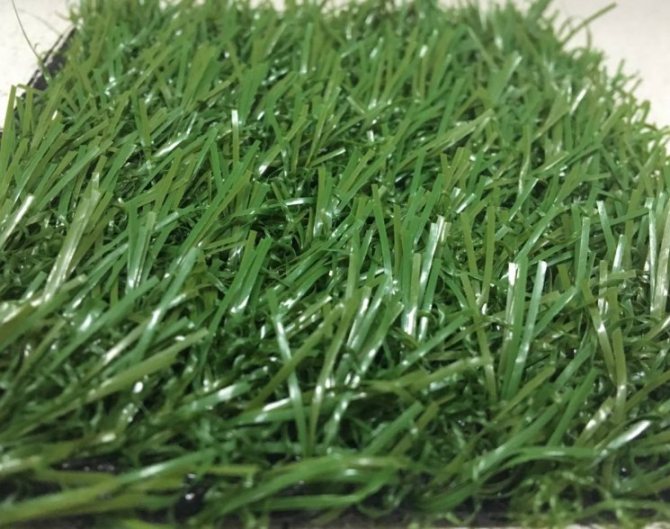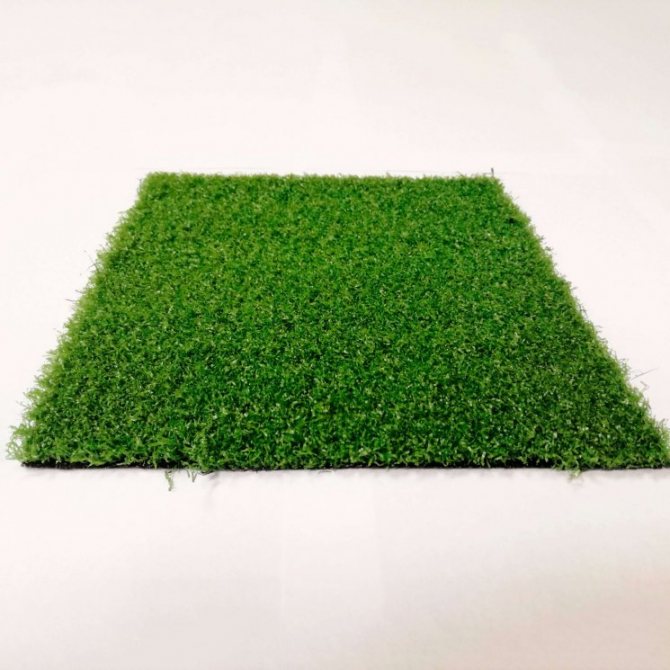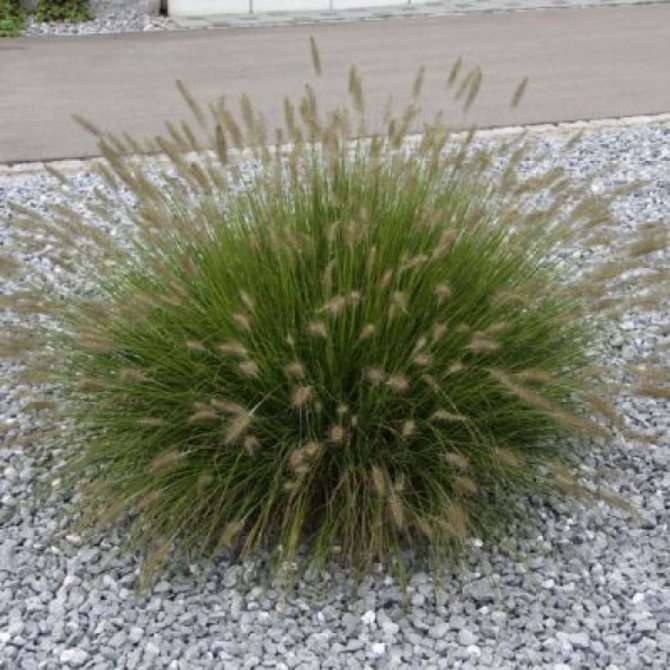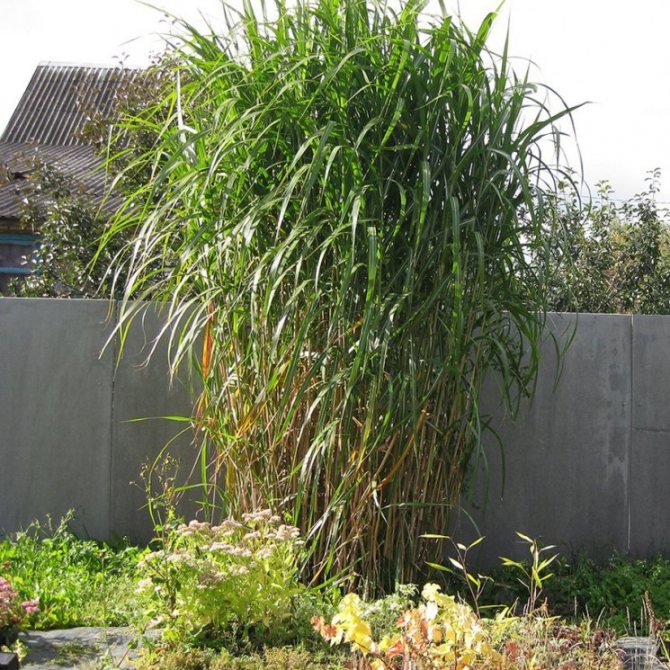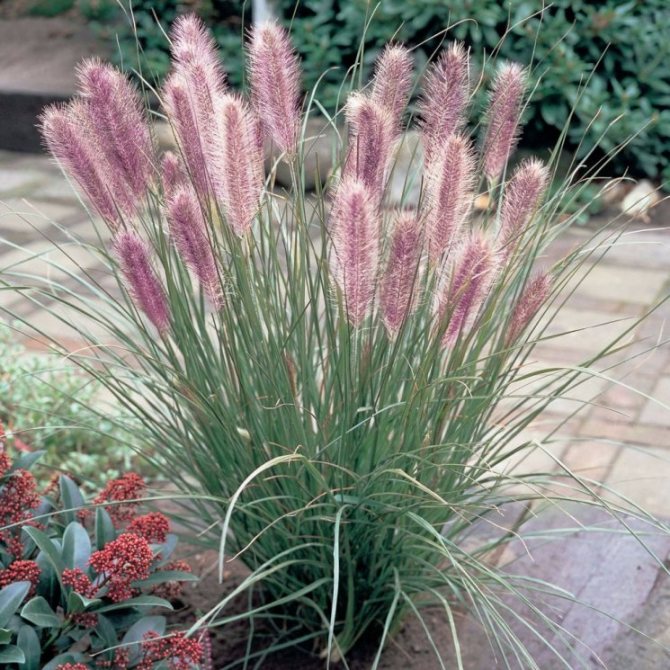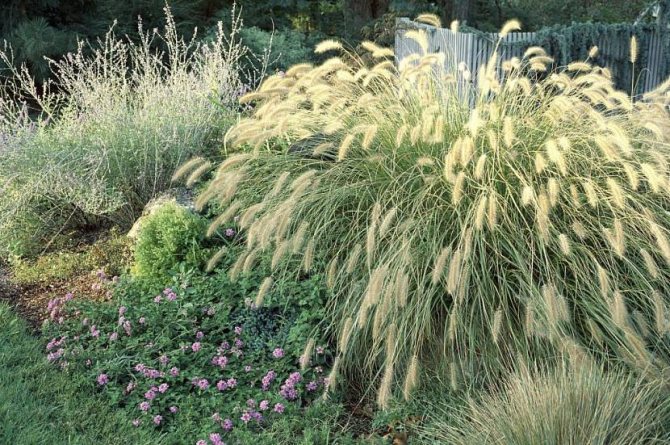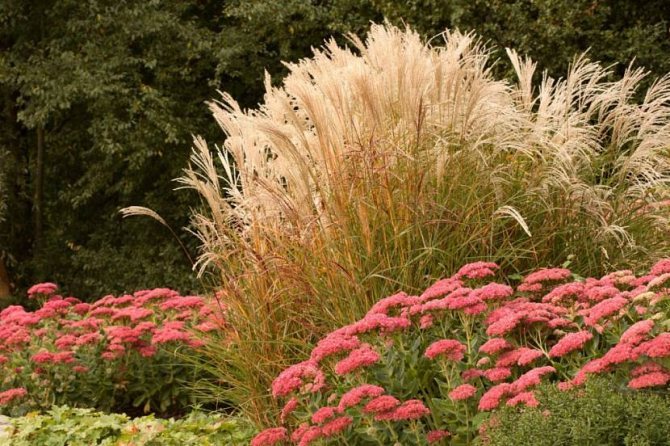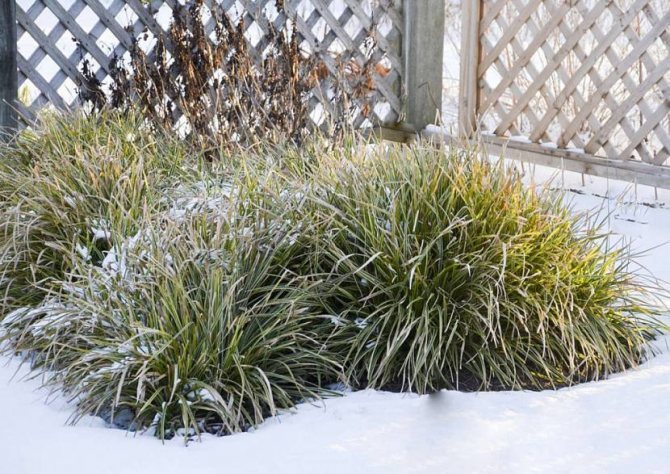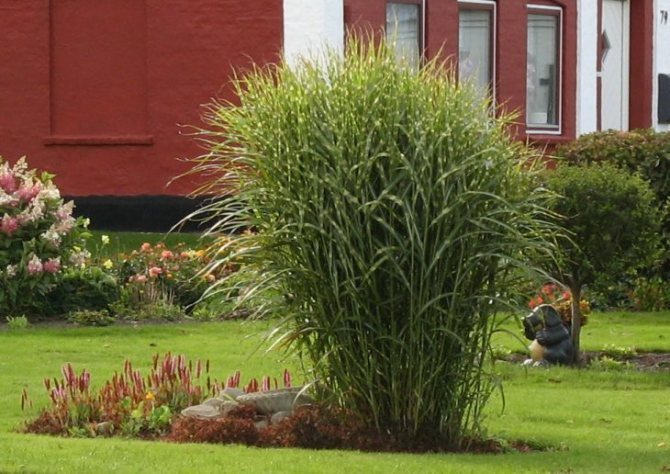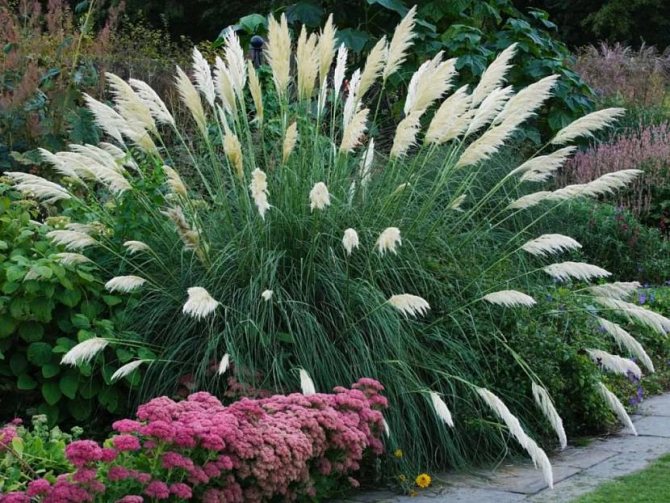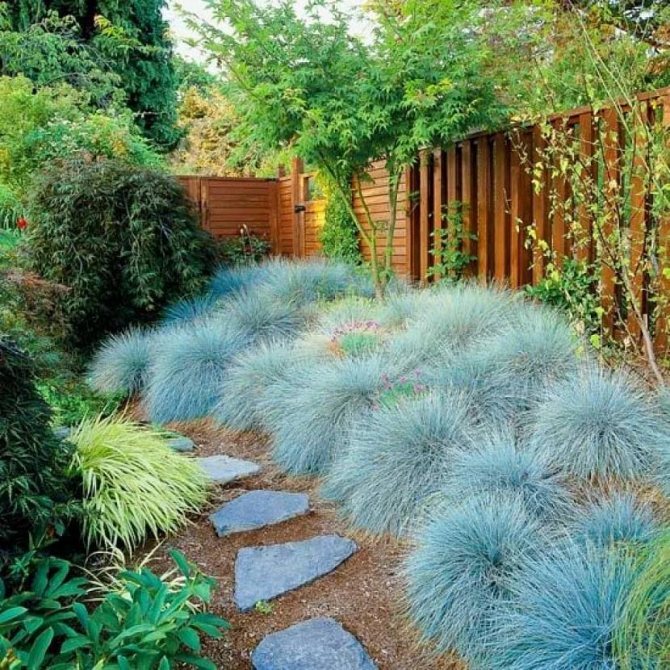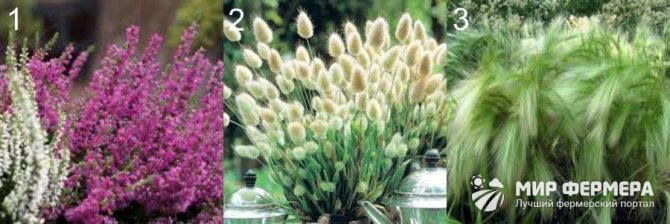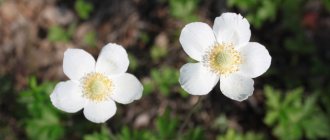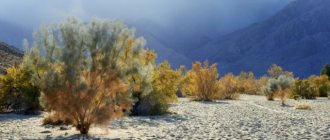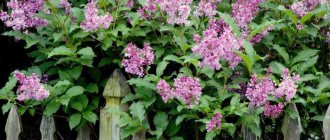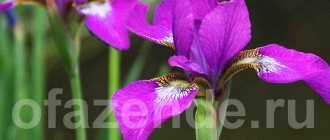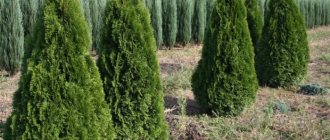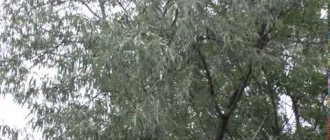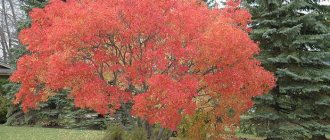Evergreen paniculata sheep botanical description
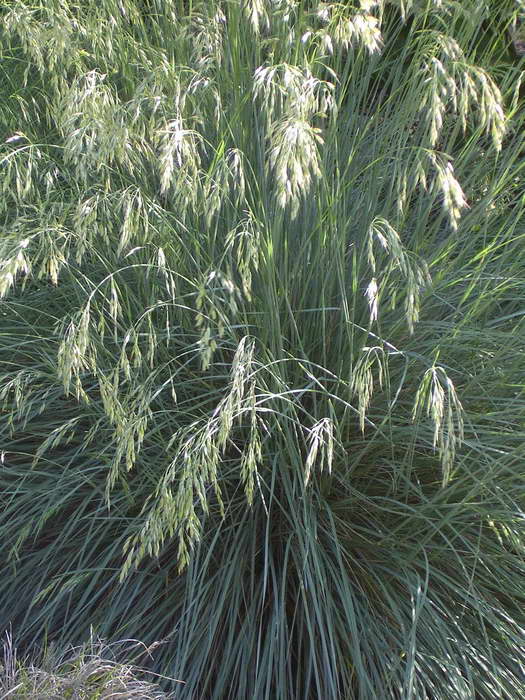
Panicled sheep blue photo
The root system is fibrous. The roots penetrate deeply into the soil in search of moisture and nutrients.
The height of the plant is 30-50 cm.If you provide suitable conditions and do not plant bushes, they can reach a diameter of about 1 m.
The leaf plates are linear, narrow: in the lower part, the width is about 1 cm, at the top they are equally narrowed, the tops are pointed. In length, the leaves are stretched to half a meter. Can be curled or folded lengthwise. The colors are green-blue or gray.
Paniculate inflorescences appear on the tops of erect peduncles up to 1.5 m long. They are soft, gray-green in color. Seemingly unpretentious, but towering above the bush, they give airiness. Flowering occurs in July.
Where grows
The homeland of this decorative cereal is the Alps and the mountainous regions of the Western Mediterranean, widespread in the natural environment of Africa, Asia, and Europe.
Application
Wild species are used as livestock feed. Landscaping is the best use for this plant.
In regions with a warm climate, oat is decorative all year round. In a temperate climatic zone, the leaves do not dry out, but they wilt under the influence of snow and frost.
Thus, the decorative effect of the bush is preserved throughout the season. Combined with unpretentiousness to growing conditions (grows best on depleted soils, resistant to drought, strong and cold winds, frost), this makes oat a unique plant for the garden.
Ornamental grasses - noble modesty
For the decoration of yards, cereals are used, which can ennoble and smooth the brightness of the flower bed or give a special charm by performing solo. There are creeping, low, medium and high specimens reaching 2-3 meters in height.
Low cereals for the foreground of the flower bed
Low-rise cereals elegantly complement any flower bed, giving it a natural look. Most grow quickly, so they can be contained by planting in metal containers without a bottom or by making metal fences buried in the ground.
Photos and names of herbs for a flower bed:
Gray fescue reaches 20-50 cm. Its gray tussocks are often decorated with compositions of stones, boulders, and also chosen as an addition to shrubs. An excellent ground cover plant, the neat islets of which bloom in the summer. Unpretentious to the type of soil, loves sunny places. Frost resistant.
Keleria comb - forms bumps up to 40 cm high. Blossoms in the middle of summer with spikelets of a purple hue. Unpretentious, but prefers sunny places. Drought-resistant, not afraid of frost.
Meandering meadow (pike) - grows from 30 to 60 cm. It forms bumps from narrow leaves of a bright color. Unpretentious in the choice of soil and drought tolerant. Winters easily.
Gray thin-legged - evergreen grass, grass height - 10 cm, and inflorescences - 25 cm. Leaves have a greenish-bluish tint. Prefers sunny places, unpretentious and frost-resistant.
Tall handsome men are a chic addition to the landscape
Many ornamental grasses for flower beds are represented by tall specimens, the use of which is possible not only in a joint composition, but also independently.Growing hummocks are most attractive during summer flowering, and in autumn and winter they will charm with variegated beauty.
Sod meadow (pike) reaches a height of 100–150 cm. Creates hummocks from many thin, long and rough leaves. Summer inflorescences are tall panicles of a silvery or bronze hue. The pike comes from Russia, therefore it easily adapts to any territory, is unpretentious to soil and watering, and is also frost-resistant. Wakes up early after winter.
Canary grass (two-strand reed) grows up to 90 to 120 cm. It is often chosen in order to refresh the green background, as it has white or beige veins. Prefers fertile soil, but unpretentious, therefore it grows in any area. Even during frost, it does not lower the stems. It grows very quickly. Wakes up early after winter.
Moliniya blue has elegant and graceful stems, reaching 150 cm. It acquires the greatest decorative effect in autumn, when purple inflorescences appear. It grows slowly, but is unpretentious, drought-resistant, withstands cold weather.
Miscanthus Is the most common decorative grain used by designers. Different species reach from 80 to 200 cm. Miscanthus is chosen for its original foliage, which creates the appearance of a fountain. A very strong plant that can become an independent accent in the garden. Prefers sunny planting sites and moist soil. Frost resistant. Photos of this herb for a flower bed confirm the royal status.
Breeding a sheep by dividing a bush
Dividing a bush is the most common breeding method. It is best to carry out the procedure in the spring (when planting in the fall, the bushes often get wet, which leads to death).
Moisten the soil well and dig out the bush. Damage to the root system is not terrible, you can even cut off the lower part of the rhizome. Rinse the rest in water, divide into parts, plant.
Subject to looseness, lightness of the soil and moderate watering, they will quickly take root and grow.
They practice this method: the bush is not completely dug out, but part of the bush is separated with a sharp shovel. But in this case, there is a risk that the main bush will start to hurt and lose its decorative effect.
Description of the plant


Evergreen sheep is a perennial cereal plant of the Myatlikov family. The scientific name is Heliktotrikhon, the folk name is desert sheep, viviparous. Schell's sheep is also him. It grows as a bush. If the plant is not planted, it can grow as tussocks.
On suitable soil, the width of the bush reaches 1 m.
Features of the structure:
- The root of the evergreen is fibrous. It penetrates deeply into the soil, supplying moisture and nutrients to the terrestrial part of the plant.
- The stems of the evergreen sheep are straight, the leaves are narrow, linear, the width at the bottom is about 1 cm. At the top, they evenly taper and end with a sharp end.
- The length of the leaves reaches half a meter. Some needle-like leaves are curled or folded lengthwise. The color of the leaves is gray or greenish blue.
- Sheep blooms with whitish or gray-green soft panicles, which appear in July. The height of the inflorescence stem reaches 1 meter. The inflorescences are unpretentious, they visually make the bush taller and more airy.
The plant is widespread in Europe, Asia, Africa. It often grows in the mountains. The Alps and the Western Mediterranean are called its homeland. Wild species are used for livestock feed. But it cannot be called a very useful forage crop. More evergreen sheep are used as an ornamental cereal.
In the southern regions, this is an evergreen plant, its leaves do not lose their attractiveness all year round. In mid-latitudes, under the influence of frost and snow, its leaves wilt in winter, although they do not dry out.
Decorative varieties:
- Pendula, the stem of which reaches 1.5 m. At the end of the stem, there is a heavy drooping inflorescence.Leaves combine gray, green, blue shades.
- Saphir Sprudel is distinguished by its bright gray leaves with a blue tint. Its silvery shiny inflorescences are especially beautiful.
- Robust will not rust even in the most extreme weather conditions.
Canary grass
- Distinctive features: perennial cereal, the leaves of which are striped.
- Parameters:the maximum height is slightly more than a meter.
Canary grass is most often found in the landscape design of Ukrainian estates. Its distinctive feature is striped leaves. Their width reaches 2 cm. The main color is dark green. And beige and cream stripes create a unique variegated pattern on the foliage of the canary grass.
The canary grass is good because it is not at all afraid of late frosts, which no, no - but also happen in the second half of spring. He also does not suffer from drought. But in general, this ornamental grass prefers moist fertile soil. If the soil is suitable for canary grass, it will instantly appear on the saturated color of the foliage.
Most often in the landscape, canary grass is used as a ground cover plant, the ideal place for which is a location located in close proximity to the water.
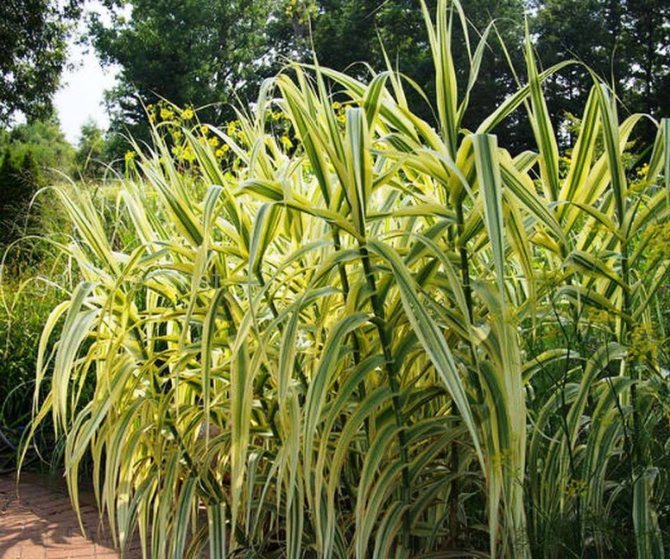

Planting sheep in open ground
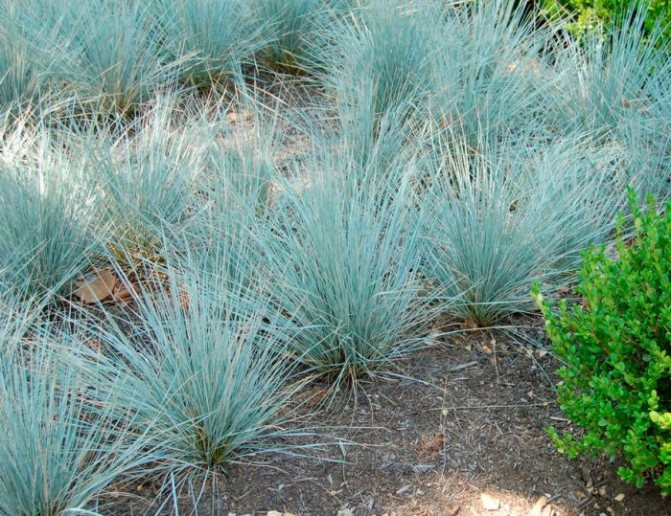

Landing rules
Gardeners prefer to propagate the oat by dividing the bush, which is a quick and easy way. If there is no such cereal in your garden yet, then you can grow it from purchased seeds. They are sown directly into open soil in spring, while they need to be buried in the ground only 20 mm. It is quite easy to care for the seedlings of this plant. They need to be watered, if necessary, and sometimes shallowly loosen the soil near the plants. The grown seedlings must be planted so that they are more spacious. When transplanting, the plant is taken with a large clod of earth.
If desired, oats can also be grown through seedlings. Seeds are sown at the beginning of the spring period. For this, individual pots are used, because by replanting or diving plants from a common box, you can easily damage their root system. When the seedlings get stronger, they must be transplanted into open soil, it is recommended to do this by transshipment. To do this, first, the seedlings are watered abundantly, then they take a knife and hold it with its back side between the substrate and the walls of the container along the entire depth. As a result, the soil mixture will separate from the walls of the pot. After that, the container is laid on its side and the bush is carefully removed from it along with the soil mixture. Then it is placed in a hole, which must be prepared in advance. The free space in the hole is covered with soil. It is forbidden to pull or pull the plant during transplantation.
A well-lit open area is suitable for growing such a crop. It will be very good if it will be located in the southern part of the garden. It is recommended to plant no more than 4 bushes on 1 square meter of the plot. When creating a hedge from a sheep during planting, a distance of 0.4–0.5 m is observed between the bushes. With a single planting of such a plant, the distance between the planted bushes should be slightly larger. Moderately dry and loose soil is optimal for growing sheep, but it should be infertile. Such a crop will not grow normally on fertile and moist soil, and shaded areas are also not suitable for it. If you plant a sheep in the shade, then its foliage will lose its decorative effect, as it will just turn green.
Kaleria
- Distinctive features:a semi-evergreen plant that has bluish, dense and slightly curled leaves.
- Parameters: the height is about 0.4 m, the diameter of the bush is about 0.3 m.
A distinctive feature of the representative of cereals called kaleria is the leaves that look exactly up and are slightly curled into a tube.The very ones about which you can cut your finger by negligence. Another feature is the rather large (especially in comparison with fescue) spikelets, which the ornamental grass throws out during the flowering period.
Kaleria is an ideal plant for a summer residence, as it remains green until the first frosts, and in the spring it releases the first emerald greens as soon as the snow melts from the ground.
It is imperative to plant kaleria on sandy soil. She agrees to grow on other light soil, but only if there is good and high-quality drainage under the bush. If moisture stagnates around the roots of the kaleria, the semi-evergreen bush will get wet and die. Therefore, the ideal place for kaleria can be considered a flowerbed with sandy soil, laid out in a sunny location.
The flowering period for kaleria begins in the first month of summer and lasts about three to four weeks. Together with fluffy spikelets, cherry-lilac panicles, which have a cylindrical shape, appear on the bush. Kaleria can be propagated easily and simply using seeds or by dividing the rhizome.
Please note that it is strictly forbidden to divide the mother bush of ornamental grasses during the flowering period. After such manipulation, the mother plant may die, and the separated “babies” are unlikely to take root due to lack of immunity.
Caring for a sheep in the garden
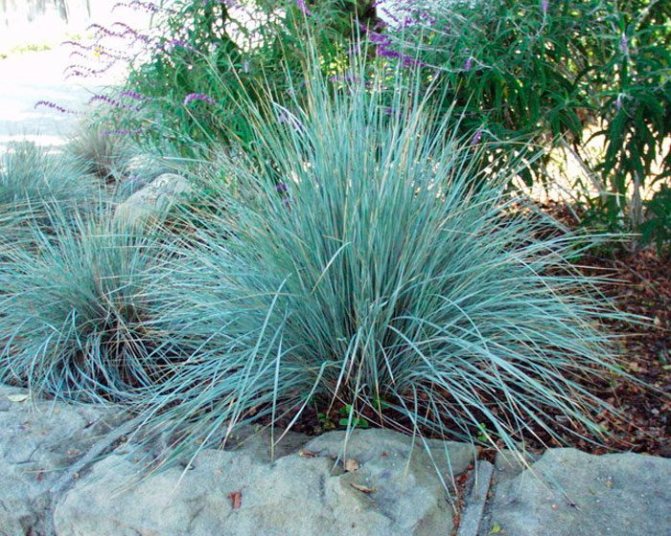

When grown in regions with a temperate climate, such a plant does not need to be watered, even on hot and dry summer days. This species is adapted to the mountain climate, so if high humidity is observed on hot days, this will have an extremely negative effect on flowering. It is necessary to water the sheep only when there is a prolonged drought, because due to a lack of water, new foliage will stop growing at the bush, and the old one will begin to dry out.
To preserve the decorative effect of such a plant, it does not need to be fed often. 7 days after planting the bush in open soil, it must be fed using a small amount of fertilizer. After that, fertilizing is carried out 1 time per season with mineral complex fertilizer.
Wintering
When the flowering of this plant comes to an end, the inflorescences that have lost their effectiveness must be removed. Such a cereal will not need shelter for the winter. During the first winter period, the color of the bush does not change and remains greenish-blue. In springtime, discolored leaf plates can be found in lush foliage, they look like gray strands. In order for the plant to become attractive again, these leaves need to be pulled out, while trying to grab with your hand as close as possible to the base of the plate. When the third winter is over, the plant will need to be rejuvenated.
Sheep breeding
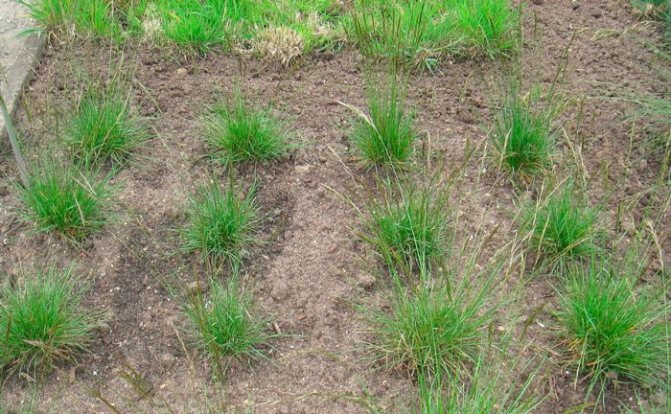

Such a cereal is propagated by dividing the bush and seeds. You can read about the seed propagation method above. When the third winter is over, the bush will lose its former beauty, so it will need to be removed from the ground, divided into parts and planted. This procedure is carried out in the spring. If the bush is transplanted or divided in the fall, then it will be very weak, and if a wet winter comes out, then there is a high probability that rot will appear on the plant. Three-year-old bushes tolerate division and transplantation well.
Pests and diseases
The sheep has a very high resistance to all pests. If the summer period is hot and damp, and the soil in the area where such a cereal grows is poorly drained, then there is a high probability that the root system of the bush will be affected by a fungal disease, and rot may appear on it in winter.
Elimus in landscape design. Sandy spike
Sandy spikelet is a very interesting ornamental plant. In the first form, it resembles a bush of ordinary grass. But in fact, it is a beautiful perennial plant in the cereal family. The second name of the spike is "Elimus sandy".
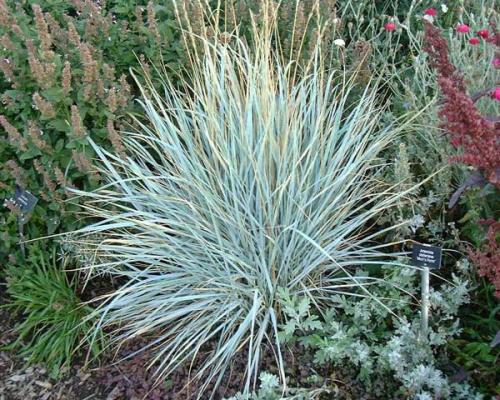

The plant is not harmful, it grows from one hundred centimeters to one hundred thirty centimeters. The leaves of the plant are blue, sharp and tall. The stems are thick. Spikelets are fluffy and thick, grow up to twenty-five centimeters in height and up to three centimeters in width. Elimus's roots are deeply planted.
The sandy spikelet grows very quickly and spreads its roots throughout the territory. Lives all year round and looks great in winter under the snow. The plant tolerates cold well and is not demanding of itself. It lives well on any soil, loves sun and drought. It multiplies quickly enough, one has only to divide the bush into young branches.
This plant is used to decorate many areas and flower beds. It will go well with other plants as well. It will also decorate the shore of a small reservoir.


Planting and leaving
Sandy spikelet, the first plant to appear in ornamental gardens. It grows remarkably in any soil, loves sun and drought. Therefore, it often does not need to be watered, usually there is enough natural precipitation. It has a bad attitude to moisture, especially when the snow begins to melt. It also does not need to be fertilized, a little feeding is enough for it.
When the site is good and conditions are right, it can grow a lot. It is sometimes confused with simple weeds. It would be nice to plant the plant in large containers with thick walls so that the roots cannot penetrate it. Such a container is usually buried in the area, leaving its sides on the surface. This is done so that there is no disorder in the gardens and everything grows neatly and beautifully.
The plant grows well without frequent transplants. Not when he is not sick and does not carry parasites, this is a big plus of Kolosnyak. In winter, during frosts, you can not hide it. But if you have large snowfalls, then it is better to cover with a film during thawing to protect it from strong moisture.


Application in the garden
Comfortable plant bushes will decorate any garden plot. They look good among other plants, keep their shape and do not wither.
Often spikelets of a plant are used to decorate decorative flower arrangements. They are cooked in the middle of summer, before the grains begin to ripen. Cut spikelets are collected in bunches of fifteen and hung upside down in a dark, well-ventilated place.
If you bought such a plant, plant it in your garden, it will delight you with its beauty and will not make it difficult to care for it.
Care advice
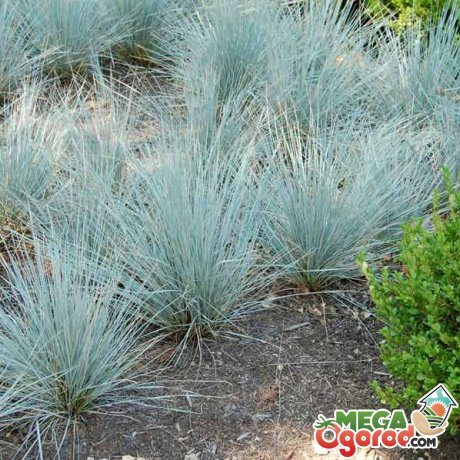

Evergreen sheep feels good in conditions close to the climate of the mountains. Does not like combinations of high temperatures with high humidity. In this case, it does not bloom well, in August the risk of rust increases, which will damage its decorative leaves.
A sheep grows in one place for about three years. Then it grows into a wide curtain and looks unkempt. In the fourth year, the bush must be divided into parts and planted so that it does not lose its decorative effect. After the panicles have faded and lost their decorative appearance, they are cut off.
How to care for a plant:
- During the first winter, the oat remains green, or rather blue, and does not lose its color. He meets the next spring with a slightly spoiled hair. "Gray" threads appear in it. So that such leaves do not spoil the general appearance of the plant, they are removed. Take it with your hand closer to the base and gently pull it out.
- After the third wintering, the bush is rejuvenated. In the fall, the entire aerial part is cut off. In the spring, the bush can be divided into several parts.
- The indisputable advantage of the evergreen sheep is that it has no pest enemies. And there are few diseases. You can fight rust by changing the growing conditions. Others will not be able to make the climate, but you can find another place where the bush will be better ventilated.
- Evergreen sheep should be watered sparingly. He needs watering during a drought.If the soil is too dry, the leaves will dry out and new ones will grow slowly.
- Evergreen sheep does not need frequent feeding. They can degrade the appearance of the plant. Fertilizers can be applied soon after planting, but in small quantities. The next year, in the spring, mineral fertilizers are dissolved in water and watered once a year.
Meadow
- Distinctive features:juicy greens of bright green color and delicate thin spikelets.
- Parameters: the height can reach a meter.
The meadow, like many other herbs and plants, in principle, has a popular name. People called him "pike". Apparently, because this representative of the flora loves moisture. Most often, in their natural environment, pike can be found in swampy areas, in forests near swamps, around rivers, ponds and other artificial and natural reservoirs. If you decide to plant a meadow in your own summer cottage, do not forget that a meadow needs moisture even more than sunlight. But such a combination happens quite rarely.
In principle, a pike will grow on acidic, dense soil. But if you want the bushes to be lush and elegant, it is worth planting this ornamental herb in fertile soil that is rich in nutrients. There is no need to fertilize the meadow. Watering is the only care recommendation. The plant is practically not afraid of diseases. Apart from the rust that occasionally infects its leaves. But this happens exclusively in the dry season and only if you break the immutable rule: stop regularly and abundantly watering bright green bushes.
The breeding method of the meadow is self-seeding. Therefore, when planting grass on the site, you will have to make sure that it does not fill the entire territory of the dacha.
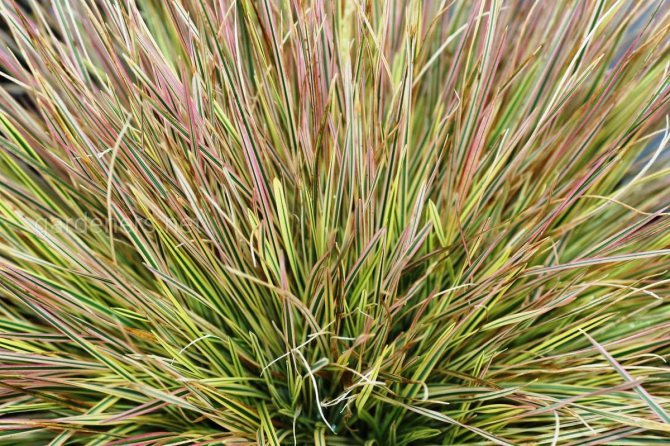

Soil for sheep
Prefers dry, loose, low nutrient content. Sheep tolerates heavy and damp soils. In the shade, the plant turns green. Poor drainage can cause roots to rot in winter and then disappear. In humid and hot conditions, flowering is weak; at the end of summer, rust can appear on the leaves of this cereal.
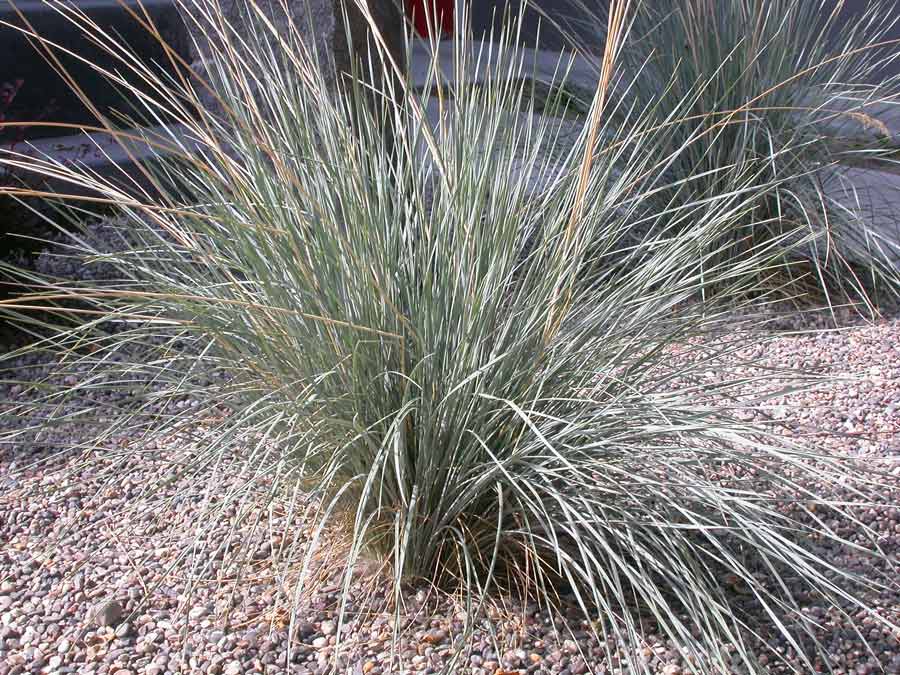

Growing a sheep from seeds
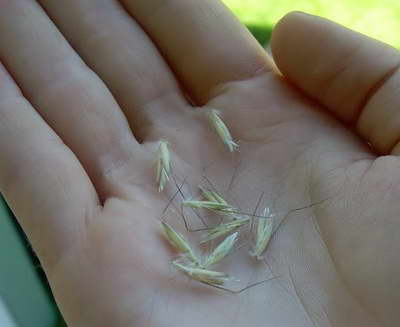

Sheep evergreen seeds photo
Sowing in the ground
Sowing oat seeds in open ground can be carried out in the spring or before winter. Cover the seeds by 2-3 cm. The area should not be trampled. Also keep the soil moist. Thin seedlings, weed young shoots from weeds.
Self-seeding is possible: do not remove panicles with ripe seeds so that they are distributed around the bush. Only a few of them germinate. Transplant the hardened bushes from self-seeding to a new growth site.
Growing seedlings
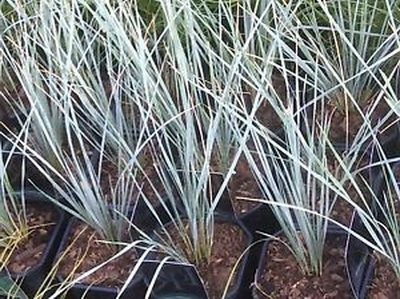

Evergreen sheep from seeds photo of seedlings
For reliability, sheep seedlings are grown at home. To do this, it is better to use individual containers (peat pots, plastic cups), so as not to injure the weak roots of young shoots during transplantation. A pick can lead to death - use the transshipment method when transplanting with full preservation of the earthen ball.
- Start sowing seedlings in early March.
- You will need nutritious soil, you can take a universal seedling substrate.
- Place 2-3 seeds in each container (then leave 1 sprout).
- Moisten crops, cover with cling film. Germinate in diffused light. Keep warm (about 25 ° C).
- With the appearance of entrances, remove the shelter.
- Continue with moderate watering and maintain good ambient lighting.
- A couple of weeks before transplanting into open ground, which is carried out with the establishment of real heat, start hardening the seedlings.
Site selection
It is best to plant the plant in a sunny area.
The soil is required to be loose, light, without flooding and moisture stagnation. The nutritional value of the soil does not matter.On the contrary, shading in combination with the high fertility of the soil gives an undesirable result - the gray shade of the leaves is lost, they turn green.
He categorically does not tolerate heavy, damp soils. Under such conditions, the rhizome rots, which leads to the death of the plant.
Heavy soil must be diluted: for digging, add coarse sand, gravel. They will serve as drainage.
Planting and caring for sheep in the open field
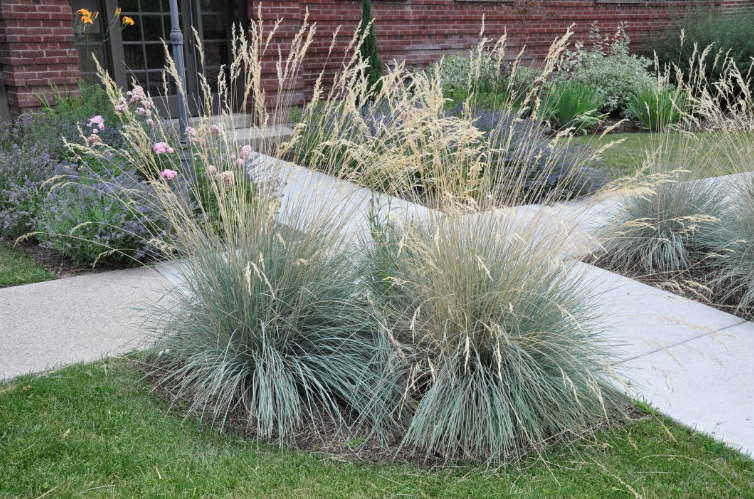

How to plant blue sheep in the open field
How to plant
The planting density is determined by the purpose of the bushes. On average, plant about 4 plants per square meter. To form a hedge, place it closer to each other, while maintaining a distance of about 50 cm. Sprawling fountains of sheep are also planted alone next to other shrubs or flowers, keep in mind that it can take a meter in diameter, but it is not at all aggressive. It grows well in one place for about 3 years.
Growing conditions
The ideal conditions for growing sheep will be close to the mountain climate. High humidity combined with high air temperatures have a detrimental effect on the plant. Sheep does not bloom well, the risk of rust damage increases.
Watering
The sheep tolerate drought well. If the soil is too dry, the tips of the leaves will dry out, new ones will develop slowly. Watering is required only during periods of severe drought. When doing this, add a moderate amount of water without making a swamp.
Top dressing
There is no urgent need for top dressing, they can even harm. A small amount of complex mineral fertilizers can be applied after planting young plants. It is enough to carry out such a procedure in the future 1 time per season - in early spring. Better to apply in liquid form.
Wintering and pruning
Winters successfully in open ground without shelter.
For the first winter, the plant leaves without pruning. In the spring, the sheep's “head of hair” does not look very decorative. White, dry leaves appear - grab them with your hand closer to the base and gently pull out. Then in the fall, the aerial part must be cut off at the root.
Transfer
After 3-4 years, the sheep grows, forming a wide clump. The bush looks unkempt - in the spring it will need to be divided into parts and planted. Cut off the panicles immediately after flowering, if you do not want self-seeding.
Ways to preserve the decorativeness of herbs for a long time
Proper care guarantees the preservation of the decorativeness of the herbs for the entire period of their life. Unlike wild-growing, ornamental grasses never lose their color and flavor. With the help of cereals, you can create unique flower arrangements that do not require special care.
In case of damage or disease of the plant, it is necessary to trim the top to about the width of the palm. If the inflorescences dry out during the growing season, they should be removed. Cut shoots can be used as mulching material for fruit trees.
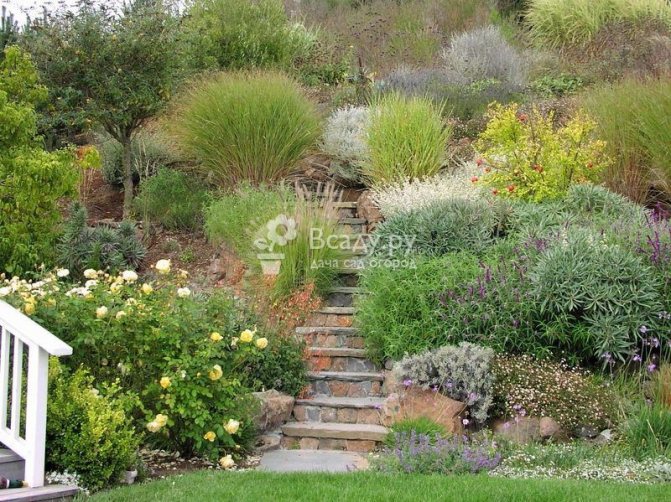

Herbaceous crops will help fill in empty areas of the garden
It is important to pay attention to the choice of the type and variety of herbaceous plants. Many cereals do not like sudden changes in temperature, and especially heat-loving ones need to create a shelter for the winter. Most often, spruce branches are used for these purposes, less often they construct a frame with a stretched covering material.
Types and varieties of sheep with photos and names
The most popular among gardeners are the following types of sheep:
Desert sheep (Helictotrichon desertorum)


This steppe species is European-West Asian. In several regions of the Russian Federation, this species is included in the Red Book and is considered endangered. Such oat is a dense sod herbaceous perennial plant. The height of the bush can vary from 0.2 to 0.5 meters. The leaves of such a plant are folded lengthwise.Narrow paniculate inflorescences consist of 2 or 3 spikelets, which reach about 1.4 centimeters in length. The fruit of the sheep is the same as that of other representatives of the Cereals family, namely, the caryopsis. This species is cultivated relatively infrequently and, as a rule, it is grown as an experimental plant.
Fluffy sheep (Helictotrichon pubescens), or pubescent sheep
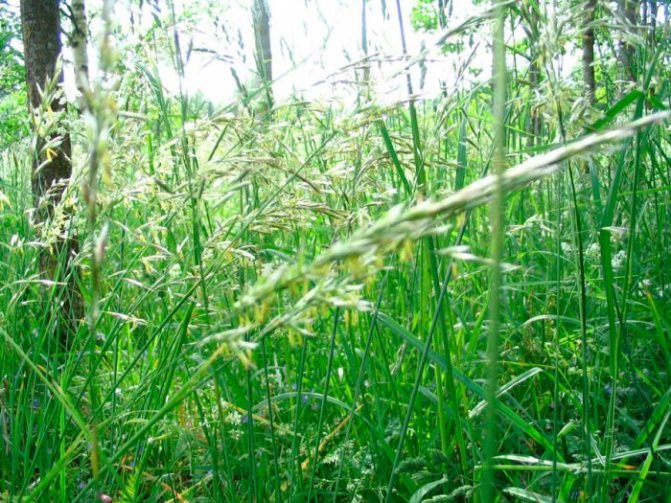

Under natural conditions, this type of sheep can be found in the Caucasus, in the European part of Russia, in Europe, Central and Asia Minor, as well as in the southern part of Siberia, while it prefers to grow in meadows, meadows and steppes. The height of the bush varies from 0.3 to 1.2 meters. The rhizome is short. As a rule, leaf plates are covered with dense short hairs, leaf width is 0.4–1 cm. The length of the paniculate inflorescences is about 15 centimeters, they include two to four-flowered greenish (found with a stripe of violet color) spikelets, the length of which is 1.2–1.7 centimeters. This fodder plant is capable of producing a rich harvest if grown in an irrigated or flooded meadow. When grown on dry soil, the foliage of the bushes becomes very tough and strongly pubescent.
[collapse]
Tonkonog
The ideal plant for slides, rocky gardens and natural drainage gardens is thin-legged... It is an ornamental perennial about 60 cm high and has bright green leaves. Stems are greenish-yellow in color, strong. The foliage is flat, straight or slightly curved, covered with short hairs on both sides, which creates a velvety effect.
In its natural environment, the grass is found in pine forests and on river terraces. The plant easily tolerates winter and is considered cold-growing. In the autumn, the soil around the grass must be mulched. Drainage soil is suitable for cultivation; in heavy clay and waterlogged soil, thin-legged ones can die.
This species begins to bloom in June-July, the inflorescences are in the form of dense greenish panicles, later golden in color. Thinfoot propagates easily with seeds, but for some varieties exclusively vegetative propagation is used.
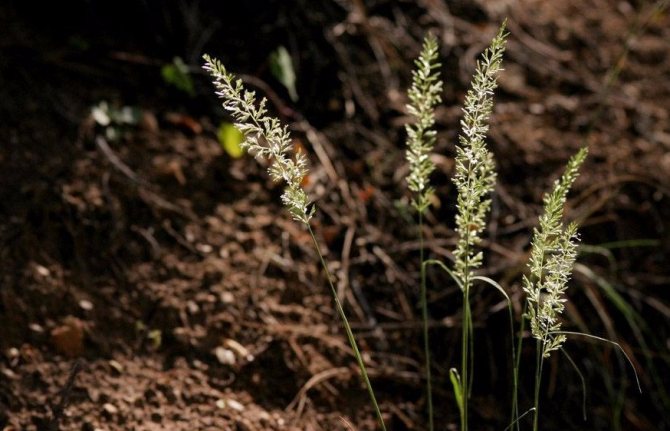

Important! When choosing seeds for ornamental grasses, preference should be given to Canadian producers, since Canada is closest to us in terms of climate and at the same time carefully controls production cycles.


